|
Behind this
legendary brand lies the work of a true engineering genius.
Karl Abarth, born in Vienna in 1908, achieved almost
unprecedented success in the field of motorsports, the
result of absolute dedication to the world of engines, and
to a truly prodigious talent, passion and feeling for
innovation.
Karl Abarth lived a long and exciting life, but here we will
concentrate on the strong, successful collaboration between
the Abarth and Fiat brands. Karl Abarth’s story did not
begin with cars, but motorcycles. When he was twenty he won
his first races on a Thun motorcycle, and the following year
he built his first motorcycle with the Abarth trademark.
Unfortunately, a serious accident during a race in Linz,
forced him to abandon motorcycle racing, but he did not lose
his desire to push himself to his limits, and he continued
to race with sidecars, a vehicle that he made popular thanks
to exploits such as the race against the Orient Express
train (won by Abarth of course). A second serious accident
in 1939 forced him to abandon racing altogether.
And so Abarth’s second life, and the real legend, began. In
1945 he moved to Merano and became Carlo Abarth, an Italian
citizen. In 1949, after working for a short time for
Cisitalia, he founded Abarth & C. The first car produced was
a 204 A Roadster, derived from a Fiat 1100, which
immediately won the Italian 1100 Sport Championship and the
Formula 2 title.
At the same time, Abarth had the brilliant idea of combining
racing activities with products for the mass market, and he
began to build his famous conversion kits for standard
production cars, that increased their power, top speed and
acceleration. Important elements in the kits were the
exhaust silencers which over the years became veritable
icons of the ‘Abarth style’. Thanks to the experience gained
years earlier on motorcycles, the Abarth silencers were the
state of the art in technological terms. The first
prototypes had a central pipe with a constant section and
side ducts in fibreglass, eliminating all the diaphragms so
as to keep gas compression to a minimum. It was a simple but
innovative system which gave his products a clear advantage
in terms of performance, and an unmistakable full, throaty
sound. In just a few years, Abarth & C. went global: in 1962
it produced 257,000 silencers with a staff of 375 people,
with exports accounting for 65% of output.
There were two extremely important elements behind the
success of the Abarth components and kits: excellent
advertising and successful racing. Carlo Abarth introduced
marketing and communications techniques that are still used
today. To convince motorists to remove their standard
silencers and install an Abarth unit, he invented a clever
advertising campaign based on an elegant presentation of the
product. Publicised with a new, revolutionary language in
the main newspapers, the silencer was presented in an opaque
black version with chrome-plated terminals, and offered at a
price well above that of the competition (4,500 lire as
opposed to a maximum of 2,000 lire). His colleagues were
initially sceptical about this new strategy, but they soon
changed their minds: it was an immediate, extraordinary
success. The first fifty units were built for the Fiat
‘Topolino’.
The success of the Abarth brand in the minds of motoring
fans was constant, incessant, and became almost overwhelming
as time passed, reaching its peak in the late 1950s and
throughout the 1960s. Carlo Abarth created the legend of the
“scorpion” with total dedication and almost frenetic
activity, which revealed the characteristics of a genius.
|
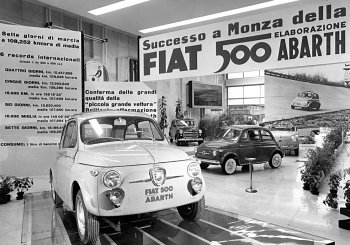 |
|
In 1958 Abarth achieved a masterpiece on the new
Fiat 500, completely transforming the small
runabout, and highlighting its huge potential. |
|
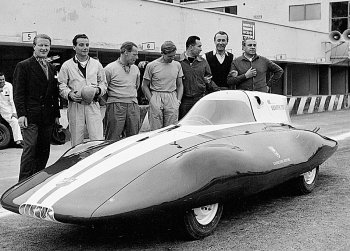 |
|
In 1956, driving a Fiat Abarth 750 (above) with a
body by Bertone, Carlo Abarth set a whole series of
duration and speed records: on June 18, on the Monza
track, he broke the 24-hour record, travelling 3,743
km at an average speed of 155 km/h. |
|
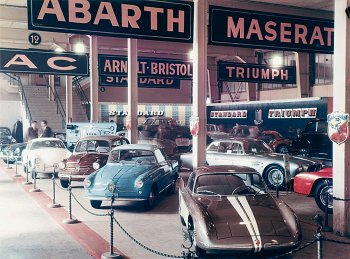 |
|
The Abarth story did not begin with cars, but with
motorcycles. When he was twenty Carlo Abarth won his
first races on a Thun motorcycle, and the following
year he built his first motorcycle with the Abarth
trademark. Photo: Abarth stand at the 1956 Geneva
Motor Show. |
|
|
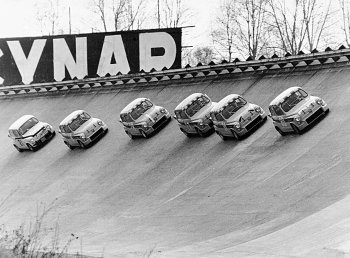 |
|
Behind the legendary brand lies the work of a true
engineering genius. Karl Abarth, born in Vienna in
1908, achieved almost unprecedented success in the
field of motorsports. Photo: 1000 Abarths during the
'4 Ore del Jolly Club' at Monza 1966. |
|
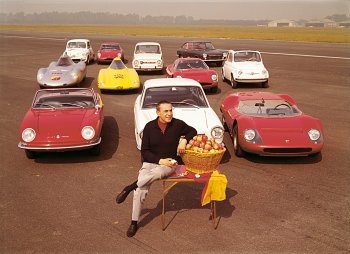 |
|
In 1945 he moved to Merano and became Carlo Abarth,
an Italian citizen. In 1949, after working for a
short time for Cisitalia, he founded Abarth & C.
Photo: Carlo Abarth with some of his cars in 1965. |
|
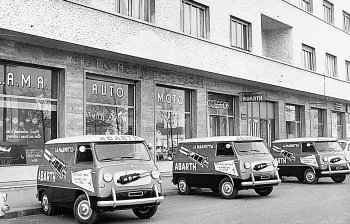 |
|
Abarth had the brilliant idea of combining racing
activities with products for the mass market, and he
began to build his famous conversion kits for
standard production cars, that increased their
power, top speed and acceleration. Important
elements in the kits were the exhaust silencers
which over the years became veritable icons of the
‘Abarth style’. |
|
|
The stages of this continuous exploit and unparalleled
success story followed one after another at a rate that is
still amazing today. A long march, punctuated with records,
triumphs, and epoch-making ideas that changed our approach
to the sports car. In 1956, driving a Fiat Abarth 750 with a
body by Bertone, he set a whole series of duration and speed
records: on June 18, on the Monza track, he broke the
24-hour record, travelling 3,743 km at an average speed of
155 km/h. Then, from June 27 to 29, on the same track, he
broke numerous other records: the 5,000 and 10,000 km, the
5,000 miles and also the records for 48 hours and 72 hours.
International success followed, and on July 21, 1956 the
influential German magazine “Das Auto Moto Und Sport”
dedicated the cover of issue no. 15 to the Abarth 750. The
same car was also available with two bodies by Zagato, the
Fiat Abarth 750 Zagato (1956) and the Fiat Abarth 750 GT
Zagato (1956). On May 11 and 12, 1957, at the 24th Mille
Miglia, there were 20 cars representing the ‘scorpion’ in
the 750 class and 16 of them concluded the race. The ‘roar’
of this extraordinary car even reached the United States:
Franklin Delano Roosevelt Jr., son of the American
President, rushed to Italy personally to sign an exclusive
agreement with Carlo Abarth to distribute the model.
In 1958 Abarth achieved a masterpiece on the new Fiat 500,
completely transforming the small runabout, and highlighting
its huge potential. That same year the partnership with Fiat
was stepped up, and Fiat undertook to reward Abarth
financially on the basis of the number of victories and
records that the stable notched up. This agreement was
behind the amazing list of victories in the coming years: 10
world records, 133 international records and over 10,000
victories on the track.
The legend grew, and entered every day language. The Sixties
were a golden decade for Abarth. The name ‘Abarth’ was
synonymous with ‘speed’, ‘courage’, ‘performance’ and
‘conversions’. The list of cars that put the Abarth name
firmly on the motor racing map was a long one: from the 850
TC, which won on all the international circuits including
the Nurburgring, to the Fiat Abarth ‘1000 saloon’ and the
2300 S, which set an amazing number of records on the Monza
circuit in spite of dreadful atmospheric conditions.
In 1965 Carlo Abarth wanted to set a record himself. On
October 20, 1965, he set the acceleration record over a
quarter of a mile and over 500 metres on the Monza track,
with the Fiat Abarth ‘1000 Monoposto Record’ Class G, 105
bhp, and the next day he set the same records for higher
classes in a 2000 cc Class E single-seater. Yet another
anecdote that says a lot about the tenacity of the man, who
had to lose 30 kg in weight at the age of 57 in order to get
into the small cockpit and drive his cars to victory.
From 1971 Abarth became part of Fiat Auto, and the last car
on whose development the founder of the brand collaborated
actively was the A112 Abarth. During the 1980s, the story
continued with other famous cars such as the Fiat 131 Abarth
which won the world rally championship, and the Ritmo
Abarth. Carlo Abarth died on October 24, 1979, under his
birth sign: Scorpion, of course.
|
|
|
|